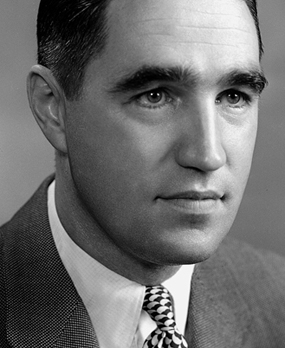How has he transformed the scene?
Born in Mankato, Minnesota in 1912, Dr. Earl Wood was a professor of physiology and medicine at the Mayo Foundation Laboratories’ Aero-Medical Unit, and was among the world’s foremost experts in the dynamics of the heart, lungs, and circulatory system.
“This guy was a towering figure. There won’t be anybody like him ever again.”
Barry Gilbert, researcher, Mayo Department of Physiology and Biomedical Engineering
He is best known for his role in the invention of the first practical anti-gravity flight suit—work for which he was awarded a Presidential Certificate of Merit by Harry Truman in 1947. Originally designed to prevent sudden black-outs of WWII fighter pilots and dive-bombers due to high acceleration, the so-called “anti-G-suit” or simply “G-Suit” was later adapted for use by astronauts in space travel. It works by using compression to increase arterial pressure in the lower body in order to maintain blood flow to the brain.
During the experimentation that informed the suit’s design, Wood and his team famously risked their lives by serving as their own research subjects in a giant human centrifuge of their own design, repeatedly subjecting themselves to g-forces sufficient to cause loss of consciousness. Vital to the war effort at the time, this top-secret work was undertaken at the request of the Army Air Force. The g-suit and pilot breathing techniques also developed by Wood’s team have been credited with saving the lives of many American military pilots, and contributing greatly to the outcome of the war by increasing the number of successful air-based missions.
Over the course of his career at Mayo, Wood continued to revolutionize medical technology and procedures, working with colleagues to perfect cardiac catheterization as a diagnostic tool, create indocyanine “cardiogreen” dye as a means of assessing heart function and defects, refine the heart-lung bypass machine, and devise a precursor to the modern-day CT-scanner. Wood also patented the oximeter, a quick and non-invasive way to measure oxygen saturation levels in the blood.
Dr. Wood taught countless students as professor in the Mayo Graduate School of Medicine and Mayo Medical School, but also trained fellow doctors and scientists who came to his lab to study his techniques. He developed a remarkable body of published literature—some 700 articles, as well as book chapters—laying important groundwork for future advances in medicine, physiology, aerospace medicine and cardiology.
After a lifetime of service to medical science and humanity, Dr. Earl Wood died in March of 2009 at the age of 97. As expressed by the American Physiological Society, ““His legacy will live on in his numerous fundamental contributions to the fields of Physiology, operational Aerospace Medicine, and most importantly through the countless trainees and students that have had the privilege to work with him and get to know him as a world class researcher, teacher, wonderful family man and human being.”
More Info
See also, pages 5 and 6, May 2009 issue, Aviation, Space, and Environmental Medicine, for a fine feature on the life and work of Dr. Earl Wood, linked below with permission:
http://www.asma.org/pdf/asma_news/may09_news.pdf

